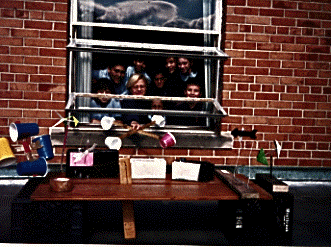Immaculate Conception School,
Somerville, NJ: Earth/Mars Weather Worlds Plan
A. The 6 instruments which we agreed to use were:
thermometer for temperature readings, barometer for air pressure, hygrometer for humidity reading, anemometer for wind speed, windvane for wind direction, and rain gauge for the amount of precipitation.
The Grade 8 Meteorologists hired 5th grade "engineers" to build 4 types of weather instruments, and we bought the other 2 for $22.00 at our local hardware store. ( We bought the combination thermometer, barometer, and hygrometer as one package for $22.00.) Ten 5th graders made 4 types of instruments out of recycled materials. (e.g. 3 hair hygrometers, 3 windvanes, 3 anemometers, and 1 rain gauge) The 5th grade "engineers" described how they built their instruments and sent this to the Weather Worlds listserve.
The hygrometers were calibrated in a wet, shower room, but for the other instruments, the students decided to accept daily approximate readings, since the 8th graders were downloading precise National Weather Station data for our area as well as 9 other United States and British Columbia, Canada areas. This decision was based on their desire to concentrate on how the instruments work, rather than depending on "primitive" instruments for precise information.] A parent carpenter built a small picnic table with recycled wood, and anchored the students' weather instruments to this rooftop "station" so that the instruments would be stable and not blow away.]
B. Meanwhile, the 8th grade students did the following: All 8th grade students researched 1 of 6 weather topics and reported their findings to the rest of their class. 8 students set up 2 spreadsheets, one for Earth National Weather Station Data, and one for Mars data. The 10 cities we chose to keep track of are : Chicago ( IL), Newark (NJ), Devils Lake (ND), Seattle (WA), Los Angeles (CA), Miami (FL), Houston (TX), Detroit (MI), Fort collins (CO), and Vancouver Airport, British Columbia, Canada.
[ This is downloaded each morning from
http://www.wunderground.com/cgibin/findweather/getForecast?addfav=00000.71201
which we customized for our needs.]
Each site was selected because of its geographical location and characteristics, which seem to contribute to differences in weather patterns. The Martian data was set up to track temperature, pressure, wind speed, and wind direction, since this is provided at the http://www-k12.atmos.washington.edu/k12/lfm/LOPS_MPF_allavg_data.html
University of Washington's Live FromEarth and Mars web site. The 8th graders decided to keep track of Earth data until our Thanksgiving break, and Martian data as long as NASA posts it, given the fact that Mars is now in its' autumn weather, and the instruments are too frozen to register and send data. Nevertheless, we feel that the August and September data would provide enough information for a rough comparison of Earth and one location on Mars. These 8 "computer technicians" began recording data to the spreadsheets on Monday, November 3rd before school from 7:30-8:00 AM.
C. Data Analysis : We are awaiting help in deepening our limited understanding of the inter-relationships of the weather factors. In addition, our 8th graders can Email questions to a meteorologist in British Columbia, Canada, who is mentoring us for this project. [...and that is why we included the Vancouver Airport in Canada on our Earth Nat. Weather data.]
Proj.Coordinator: Sister Dianne Mollica -- Sister Dianne Mollica, IHM Immaculate Conception School, 41 Mountain Ave. Somerville, New Jersey, USA
http://dimacs.rutgers.edu/~dmollica/starttoys.html for Lunar/MartianToys
http://www.njin.net/~dmollica/index.html for Kids on the Moon
http://aesop.rutgers.edu/~dmollica/hydrostart.html for Hydroponic Vegetables

![]()